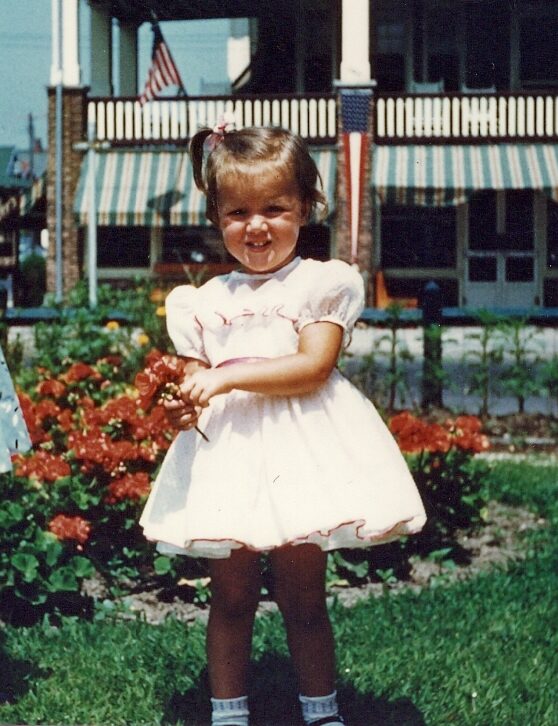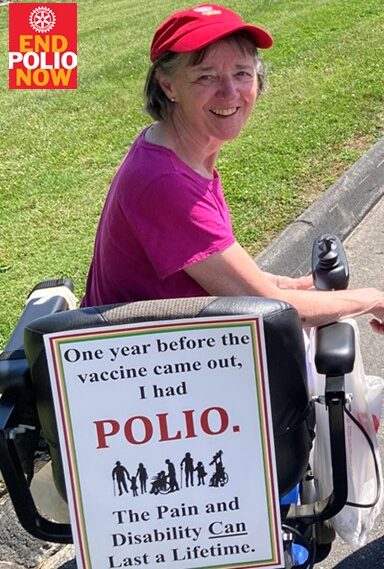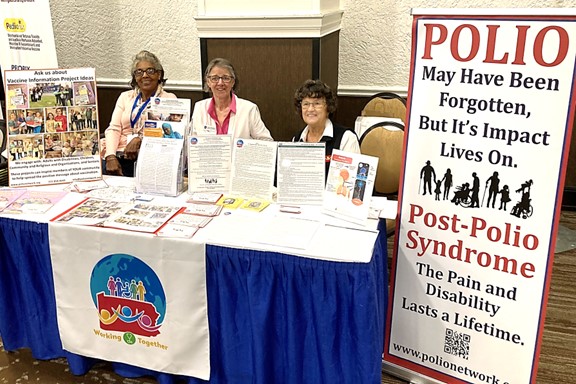Carol
A Polio Story
Place of Residence: Bucks County, PA
Carol’s post-polio journey was long, painful, and truly confusing. There was a diagnosis, a frightening misdiagnosis, and an enormous amount of self-doubt. Finally, in the fall of 2013, Carol felt like she was finally “there.” Polio was no longer defining her life.
Carol shares her story of how she became a passionate polio survivor and vaccine advocate.
How has your journey with polio and post-polio syndrome (PPS) impacted your life?
I am a “non-paralytic” (often referred to as “inapparent”) polio survivor with PPS, which has brought both limitations and new abilities. Have I discovered the limitations that came with my disability? Yes. Have I discovered new and pain-free abilities? Yes. Through understanding and acceptance, I have learned to thrive despite my condition. With that, I developed a new kind of energy.
How did you first discover that you had polio?
All I have is a memory of being taken to Temple University Hospital in Philadelphia when I was 12. I had developed a “drop” foot that was becoming more significant. I still remember that kind physician taking one look at my foot and telling my parents “THAT is a polio foot.”

He went through my history with my mother, and when he heard the words “She did have the summer grippe when she was two,” he smiled and responded, “We now know that the summer grippe was often a ‘mild’ case of polio.”
The word “polio” was never spoken again, although my mother still referred to my left foot as my “funny” foot. She didn’t scold me quite so much for the way I walked after that. Although it was always there, what followed (quite noticeably beginning in my twenties) was a lifetime of what we now know to be the late effects of polio, or PPS.
Looking back, what else do you remember about how polio impacted your life in your younger years?
Muscle twitching, spasms and weakness in my left leg were a normal occurrence. I remember an instance where my left foot kept cramping up in my ice skate when I was trying to play hockey with my young sons. I ended up falling as a result and broke my elbow. A few months later, I needed minor outpatient surgery, during which my left leg started uncontrollably flipping on the gurney after they gave me a pre-op sedative. The next thing I knew, I woke up very sick in the ICU. The anesthesiologist conducted a lengthy and exhaustive interview because he was convinced that I had omitted something from my medical history. Finally, I told him that I was told I may have had a mild case of polio as a child. He was adamant that this was the explanation and told me that I must never leave that out of my medical history again. To me, it was just a childhood story. Little did I know, he was one of the few anesthesiologists in the mid-1980s who was knowledgeable about PPS.
In my forties, I was facing significant and rather frightening muscle weakness and spasms in my left leg and upper left side of my body, but doctors couldn’t pinpoint the cause. Something was wrong, but what was it? No one seemed to have an answer. All I had was a memory and a gentle scolding from an amazing physician. After an accident, my upper left back and neck pain became all-consuming, leading to an electromyography (EMG) and nerve conduction study in my neck. That was one of the most horrifying experiences of my life. The EMG physician was clearly annoyed, and the room was uncomfortably cold. The pain was unbearable. When I asked him to stop the test, he loudly declared that there was “no sign of polio.” I’ve never before or since asked a physician to stop a procedure.
At a follow-up visit, the spinal physician reviewed my EMG results and asked me to stand, keeping my left heel on the floor while lifting the front of my left foot. I discovered that I couldn’t do it, though my right foot did it easily. What did this have to do with my back pain, I wondered? This physician, who had interned with a leading post-polio specialist in Philadelphia, gently suggested it was time to see her and that they would be “bracing me up.” No one was going to slap a brace on me, I thought. Besides, the EMG showed “no polio.”
Months later, my left knee went in a direction that clearly didn’t seem right. When I asked the doctor to “strap it back where it should be,” he confidently declined and made other plans. It turned out that the same physician my spinal orthopedist had interned with was his cousin! What a coincidence! The next morning, my husband and I were in Philadelphia with that physician who ran the polio clinic. After measuring my leg and watching me walk, she diagnosed me with PPS, gave me a booklet of information, and scheduled an appointment with an orthotist for a brace.
Over the next year, there was lots of treatment but no reduction in pain. The brace had reduced my stumbling, but my upper back pain and weakness worsened. Despite the care, the physician could only address my leg weakness, leaving me with ongoing pain and confusion.
Although it was always there, what followed (quite noticeably beginning in my twenties) was a lifetime of what we now know to be the late effects of polio, or PPS.
What finally led you to get a correct diagnosis for your symptoms?
My journey took me and my ever-supportive husband to numerous neurologists and endless tests, with suspicions ranging from multiple sclerosis (MS) to brain tumors. One neurologist even told me that it wasn’t possible for inapparent or “non-paralytic” polio to cause such extensive damage. Everyone agreed something was wrong, but all I had was a memory, a PPS “diagnosis”, and a test that showed I hadn’t had polio. But the doubts were always there.
The internet was still new to me, but I found the Post-Polio Institute in Englewood, NJ, which was an integrative clinic that served polio survivors nationwide. When I called for an appointment, they asked me for a six-week commitment. By the time I started the program, I was in bad shape. Once again, their professional staff agreed that something was wrong, but didn’t know exactly what it was. Although there were symptoms of post-polio, there was no proof that I ever had the virus.

The program director, Dr. Richard L. Bruno, PhD and his associate, Dr. Gerald Zimmerman, MD were unhappy with the way my previous EMG was conducted and insisted on another. A well “credentialed” neurologist back home conducted another EMG on my left leg while I was standing and noted on the report that the results were “bizarre” but showed no evidence of the damage from an old polio. Back at Englewood, Dr. Bruno and his associate believed the test was done incorrectly again and suggested another. I was tired, angry, and unhappy. Although I didn’t like Dr. Bruno’s responses to the tests, I was fascinated by and grateful for his determination to help me get to a correct diagnosis. He was the only professional I had seen who was seeking proof of an old polio, prior to confirming a PPS diagnosis.
How did that diagnosis change your life?
My husband and I were sure it was no coincidence that the two amazing PhDs in my life (Richard Bruno and Daniel Wilson) had the approach that would change my life forever. Daniel J. Wilson, PhD, recommended a specially trained neurologist for a third EMG. He found it. With the proof of damage from old polio came the correct diagnosis and my journey to wellness could finally begin! For six years, I followed the program at the Post-Polio Institute in Englewood. This program provided outstanding physical and occupational therapy, taught correct posture, the importance of reduced walking, effective bracing, post-polio nutrition, and energy conservation. For six years I opened myself up to learning not just about the physical side of polio, but also the mental and emotional damage that comes with this terrible virus. My family finally understood what was happening to me. Both my primary care physician and my physical therapist of many years had the benefit of being taught by the professionals at the Post-Polio Institute. I will be forever grateful to the two PhDs that led me to this place in my life.
My father never spoke the word “polio” – even when he saw me in a brace and walking with a cane. My mother would live to see me progress to a mobility scooter, and I could always see the pain in her eyes. One day, at age 90, she told me that deep down she and my father always knew I had polio, but because I got better on my own with minimal (if any) side effects, they said nothing. They always blamed themselves.
How has your experience with post-polio syndrome influenced your advocacy efforts that support polio survivors and vaccination awareness?
Early in 2014, writing stories for my support group was no longer enough. I was grateful beyond words for having had the best care (and yes, the worst prior to that). I didn’t want others to continue having these experiences. My journey with PPS has fueled my passion for advocacy and raising awareness about the lifelong impact of polio. This led me to start the PA Polio Survivors Network in early 2014 with fellow survivor Jim Smith, my husband, and a few amazing friends. We thought our work would be complete in just a few years – but our journey continues! In 2015, our volunteer team grew, and we were joined by survivors Deb Stambaugh and Joe Randig.
With enormous gratitude, our list of professional contributors, survivors, and friends has grown significantly. We are very grateful for the support of Richard L. Bruno, HD, PhD, Marny Eulberg, MD, William M. DeMayo, MD, Post-Polio Health International, Daniel J. Wilson, PhD and a host of additional professional contributors.
Now in our 10th year, PA Polio Survivors Network has become “Polio Survivors Serving Others.” The mission of our Polio Survivors Network is to serve all polio survivors, both in the US and abroad by providing information for them, their families and caregivers. We draw attention to the importance of being immunized against polio and all crippling childhood diseases.
What message do you hope to convey to others, particularly regarding the importance of vaccination and understanding the long-term effects of infectious diseases like polio?
Twenty years post-diagnosis, I remain fairly stable and am grateful for the outstanding care I had for those six years at the Post-Polio Institute. I’ve learned to avoid steps, rest, and say the word “no.” I see a physical therapist who specializes in PPS, who helps me with gentle stretching and myofascial release that reduces pain. The reality of PPS is that, with the activities of daily living, muscle weakness and pain can increase.
I am living proof that a “mild” or “inapparent” case of a virus can cause lifelong damage. Polio is not a “one and done” virus that attacks and leaves.
My experience with PPS underscores the importance of vaccination in preventing the spread of infectious diseases and protecting future generations from suffering similar long-term effects. By sharing my story, I hope to inspire others to vaccinate themselves and their families so they can live long, healthy, productive lives.
Polio survivors and our families realize that No Child Should Suffer from a Vaccine-Preventable Disease. We understand, without question, that the pain and disability CAN last a lifetime.
BECOME A VACCINE ADVOCATE
There are lots of ways you can make a difference in your community.


